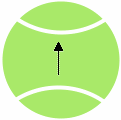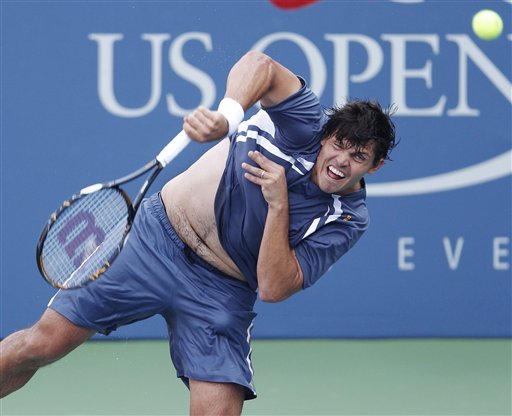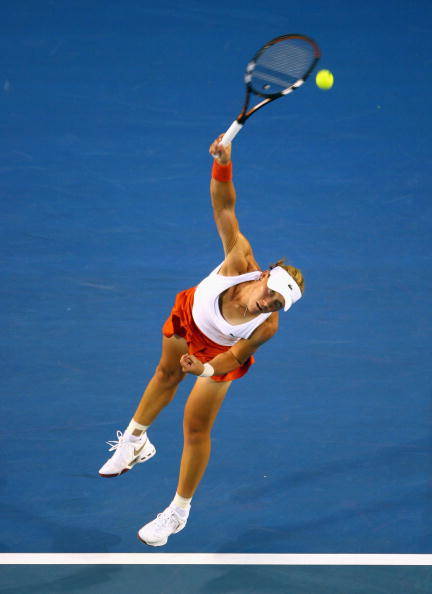Although the tennis spin serve is not as popular as the flat serve, it is just as important to master this type of serve to keep your opponent from getting into a rhythm and predicting your serve placement.
Because it is the first shot in every point, the serve determines how the point will be played and whether you can start it out with the upper hand immediately. The serve is supposed to provide an advantage in winning points so you should make the most out of your service games. If you get broken too easily, you will be under constant pressure from your opponent, especially if he or she is serving well on that day.
Learning the Tennis Spin Serve
If you are getting broken easily, you should assess why this is happening. A lot of times, it is because you simply hit the ball too softly to threaten the returner. However, many times, even if you do have good serve speed, you still can get broken because you are being too predictable with where you place your serve.
Additionally, you might not be hitting it with enough variety to keep your opponent guessing on the return. Even if you don’t have very good disguise, you can keep the receiver from establishing a rhythm with his or her return by varying the spin of your serve.
Benefits of using a Tennis Spin Serve
Learning the different tennis spin serves will help to add more variety to your game. Spin also enhances control so these make for better second serves. Aside from that, hitting your first serve with spin can help increase your first serve percentage in order to take pressure off your second serve.
This is crucial if your opponent is being aggressive on his or her return. Spin serves also travel more slowly through the air but can still be difficult to return because of the way the bounce. Therefore, these shots are excellent for times when you want to come in and volley immediately, like when you are playing doubles.
Understanding the Different Tennis Spin Serves
The main types of spin are topspin, slice and sidespin. Topspin is when the ball is spinning forward as it travels along its trajectory. Slice is also the same as back spin or under spin. The ball is spinning backward along its path. Side spin is when the ball is rotating along a vertical axis relative to its direction through the air.




All tennis spin serves have a degree of sidespin. The three major tennis spin serves are the kick serve, which is characterized by having more topspin than sidespin; the twist serve, which has roughly equal amounts of topspin and sidespin; and the slice serve, which has backspin and sidespin.
Tennis Spin Serve Technique
The techniques of the various tennis spin serves are dependent on the type of ball toss appropriate for each. The basic principles of hitting the serve all apply.
Learning the Tennis Kick Serve


For the Tennis Kick Serve, it if often necessary to toss the ball slightly to the left of the head and directly above the head for the most effective production of spin needed for this serve
For the kick serve, the acceptable grips are the continental and eastern backhand grips. The toss is up over the head. If you let the ball drop to the ground, it should drop behind your left shoulder if you are right handed. Because of this, the back will be arched slightly at the trophy pose phase of the stroke.
As you launch up to hit the ball, keep looking up at it and concentrate on hitting the ball from the 7 o’clock to 1 o’clock position. For left handed players, this would be the 5 o’clock to 11 o’clock position. Brush the ball upward and pronate your forearm through contact. Your resulting follow through will be on the same side of your body as your hitting arm.


The follow through for the tennis serve: Marked by a pronounced pronation of the hitting arm allowing the racket to decelerate – a key to achieving a world class serve
Tennis Twist Serve Technique


The twist serve is basically the same as the kick serve, except that contact is made from the 8 o’clock to 2 o’clock position for right handers (4 o’clock to 10 o’clock for lefties). This exaggerates the side spin.
The slice serve uses a more similar toss as the flat serve. The more similar the toss, the better it will be because of the disguise that can be provided. This toss goes out in front and to the right. It is usually a little lower than the kick or twist serve toss. The preferred grip is continental.
The technique is basically the same as the flat serve except that at contact, you use your wrist to brush the racket head around the right side of the ball (or left side for lefties) and downward to produce sidespin and backspin. You should also hit through the ball in order to give it penetration. Simply hitting it with spin will make the ball sit up.
Each tennis spin serve has a unique trajectory and bounce that can be disconcerting for the returner. For right handed servers, kick serves cross the net high and curve downward into the service box before bouncing high and a little to the left side of the receiver. Because of the spin, this is a good option for those who want to serve and volley.
The height with which the ball crosses over the net and the way it curves into the box make it usually the first choice as a second serve. On a hard court or clay court, this serve is very effective for setting up the point because these surfaces accentuate the height of the bounce.
Advantages of Using the Various Spin Serves in Tennis
Many players struggle to return very high bouncing kick serves. They can move way back and let the ball drop a little but that would give too much ground to the server. If they move in to take the ball on the rise, their timing has to be perfect to hit the return well.
A high bouncing serve is also valuable against a player with a one-handed backhand. Aiming this to the hip of the returner also makes it uncomfortable for him or her because the ball will be jamming into the body.
The Effect of a Tennis Twist Serve


For right handed twist serves, the ball crosses the net similarly as the kick serve. But instead of just simply curving downward into the service box, it curves to the right of the returner before bouncing out to the left. This seemingly twisting motion gives this serve its name.
This can be very confusing for the returner and really disrupt his or her rhythm. Its leftward bounce means that it will play to a right handed receiver’s backhand, which is usually the side less adroit at hitting awkwardly bouncing balls.
This is good for stretching out a player with a double handed backhand. It is also awkward for players with one-handers especially if they aren’t good at handling the bounce.
When aimed at the right side of a right handed receiver, it can present a tough challenge because he or she will tend to prepare with a forehand but find that the ball will instead bounce sharply toward the backhand side.
Effect of the Tennis Slice Serve


The slice serve has the opposite effect of the twist serve. It bounces low and to the right side of the receiver. It crosses the net lower than the kicker or twister but still makes a good alternative for a second serve because it is still less risky than a flat serve.
Making the ball bounce low and wide to the forehand side of a right handed receiver keeps him or her from getting grooved on the return. If he or she has been running around the backhand to return, this type of serve will catch him or her off guard.
It is also valuable against players who use western grips and are not too comfortable with low balls curving away from them.
This serve is effective on all surfaces, especially grass because the ball bounces even lower. Serve and volley players love to open up the court with this shot. To use it as a jammer, it should be aimed at the left hip of the returner. He or she will be looking at a ball coming over to the left but then bouncing sharply over to the right.
Examples of Using a Tennis Spin Serve


Tennis spin serves are major weapons of left handed players. There have been left handers who don’t really have great serving mechanics, but are tough to break simply by virtue of the reversed spins they produce.
The best example is Rafael Nadal. The slice serve is a lefty’s most useful serve because it bounces wide and low to the backhand side of a right handed returner. This allows them to exploit the backhand side which is usually the weaker side.
It also exposes the limited reach of the double handed backhand. John McEnroe and Martina Navratilova used this shot to set up countless winning volleys. The slice also presents a tough ball to return when it is aimed at the right hip.
How to Hit an Effective Tennis Spin Serve
The low and inward bounce makes the returner have to get out of the way and lift the ball up – something very unusual to do on the return. The kick serve and twist serve are also disconcerting when hit by a lefty. Even though these serves play more to the forehand side of a right handed returner, it can be tough due to the high bounce or the way it can curve away.
Simply put, anyone who is able to use the flat serve and the different tennis spin serves in all kinds of ways will always be tough to break. When you keep holding serve, you’ve already won half the battle.
Learn to Hit a Forehand Like Roger Federer
If you want to jumpstart your forehand and play like the PROS, check out my 70+ page Tennis Ebook that will immediately show you how you can take your forehand to the next level.
The Modern Forehand Domination Ebook is guaranteed to improve your tennis technique, and increase power, topspin and accuracy of your tennis forehand!
Modern Tennis Forehand Ebook
Learn How to Hit a Forehand Like Federer, Nadal and Djokovic

